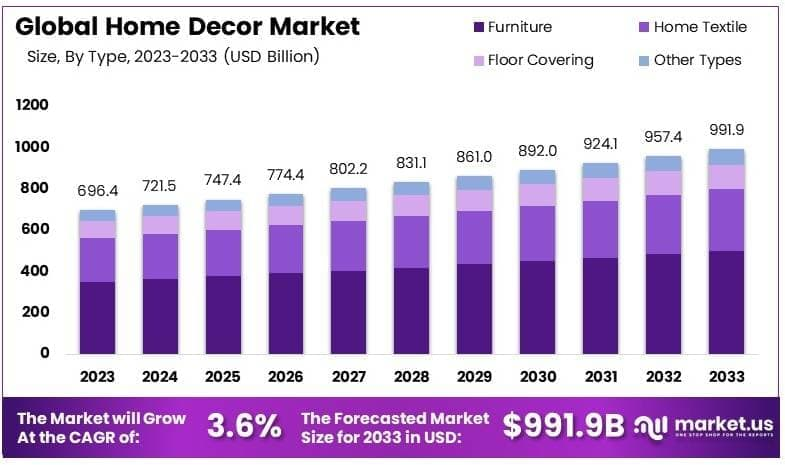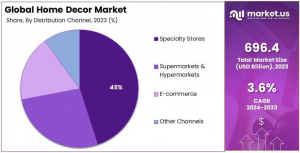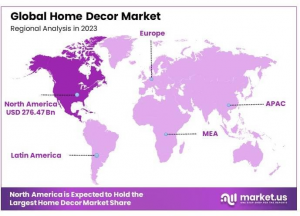
Home Decor Market to Reach USD 991.9 Billion by 2033, Growing at a CAGR of 3.6%

Home Decor Market Size
The Home Decor Market size is expected to be worth around USD 991.9 Bn by 2033, from USD 696.4 Bn in 2023, growing at a CAGR of 3.6% during the forecast period.
NEW YORK, NY, UNITED STATES, January 22, 2025 /EINPresswire.com/ -- Report Overview
According to a report by Market.us, the global home decor market is set for steady growth, projected to increase from USD 696.4 billion in 2023 to USD 991.9 billion by 2033, reflecting a compound annual growth rate (CAGR) of 3.6% during the forecast period.
This growth is fueled by rising disposable incomes, heightened interest in home personalization, and the increasing prevalence of online shopping platforms, which have transformed the way consumers access and purchase home decor products. The sector encompasses a diverse array of products, including furniture, textiles, lighting, and floor coverings, each seeing continuous innovations in design, materials, and functionality to meet shifting consumer preferences.
A significant factor contributing to the market's expansion is the proliferation of e-commerce channels, which have made it easier for consumers worldwide to explore and purchase home decor items. The convenience of online shopping, coupled with detailed product information and virtual visualization tools, has attracted a broader customer base. Additionally, the market benefits from trends such as an increasing number of new homeowners and a growing inclination toward home renovation and remodeling projects, which have boosted demand for contemporary and stylish decor solutions.
The emphasis on sustainability has further reshaped the industry, with companies developing eco-friendly and customized products to cater to environmentally conscious consumers. Innovative use of materials, such as recycled wood, organic fabrics, and energy-efficient lighting, reflects this shift. Regionally, North America continues to dominate the market with substantial revenue shares, driven by established players and high consumer spending on home improvement. However, regions like Asia Pacific and Latin America are emerging as significant growth areas, fueled by rapid urbanization, a growing middle-class population, and increased home improvement activities. These dynamic trends underscore the sector’s potential for further evolution and expansion in the coming years.
Need More Insights? Speak with Our Experts or Request a Full Report Here - https://market.us/report/home-decor-market/request-sample/
Key Takeaways
~ The global home decor market will grow from USD 696.4 billion in 2023 to USD 991.9 billion by 2033 at a CAGR of 3.6%.
~ Furniture is the dominant category, accounting for 50.4% of the market, driven by its essential role in home aesthetics and functionality.
~ Specialty stores are the leading distribution channel, representing 45% of market share due to personalized customer service and expert product curation.
~ North America holds the largest market share at 39.7%, propelled by high consumer spending and trends in home improvement.
~ The growing demand for personalized, sustainable, and high-quality home decor items presents significant market opportunities.
Regional Analysis
North America holds the largest share of the global home decor market, contributing approximately 39.7% of the total market revenue, valued at USD 276.47 billion in 2023. The region benefits from high disposable income, a well-established retail infrastructure, and a strong consumer focus on premium, customizable home decor options. The growing influence of interior design trends, particularly through social media and TV programs, continues to drive consumer behavior in the region.
Additionally, the presence of leading retailers and e-commerce platforms further boosts market accessibility. In contrast, the Asia Pacific region is experiencing rapid growth due to urbanization, rising disposable incomes, and increasing home improvement activities, particularly in China and India. The Middle East and Africa, though smaller in market share, see significant growth driven by luxury decor trends, with the UAE and Saudi Arabia standing out as key players. Europe and Latin America also show stable market growth, supported by rising demand for sustainable designs and increasing homeownership in countries like Brazil and Mexico.
Market Dynamics
The home decor market is witnessing substantial growth, driven by evolving consumer preferences and socio-economic factors. The rise in disposable income, coupled with the growing desire for personalized living spaces, has significantly boosted demand for home decor products. Items like custom furniture, home textiles, and decorative accessories are becoming increasingly popular as individuals prioritize both functionality and aesthetics in their homes.
The surge in remote work has further amplified the need for well-designed home offices, prompting higher investments in furniture and space optimization. Additionally, a shift towards sustainability is reshaping consumer behavior, with a growing preference for eco-friendly materials and products that align with environmentally conscious lifestyles.
However, the market faces notable challenges that may limit its growth. One major issue is the scarcity of skilled labor, which affects both the quality and availability of customized designs. Economic fluctuations also impact consumer spending, particularly in luxury home decor segments, as financial uncertainties tend to dampen discretionary expenditures.
Despite these restraints, significant opportunities lie in emerging markets, where urbanization and rising incomes are driving a strong demand for home improvement and decor solutions. Furthermore, the expansion of e-commerce has opened new avenues for market players to reach a broader audience. Technological innovations, such as 3D printing, are also paving the way for unique and affordable decor options, enhancing consumer choices.
Purchase the Complete Report Now with up to 30% off at https://market.us/purchase-report/?report_id=32585
Report Segmentation
By Type
The home decor market encompasses several key segments, each contributing to its growth and diversity. The home textile segment, including products like curtains, rugs, cushions, and bedding, plays a significant role, driven by the rising demand for comfort and style in residential spaces. Floor coverings, such as carpets, tiles, and hardwoods, enhance both the aesthetic appeal and functionality of living areas, supporting steady market growth. Furniture, the largest segment with a 50.4% market share, remains critical to the industry, fueled by the increasing demand for multifunctional, space-saving, and personalized designs. Additionally, other types of decor, including lighting, wall art, kitchenware, and accessories, complete the setup, offering a wide variety of styles and materials to cater to individual preferences and tastes.
By Distribution Channel
The distribution of home decor products varies across several key channels, each catering to different consumer preferences. Supermarkets and hypermarkets, while experiencing growth, hold a smaller market share due to their limited specialization in home decor products compared to other retail formats. Specialty stores, which lead the market with a 45% share, are highly favored for their high-quality, curated offerings and personalized service. E-commerce platforms are rapidly transforming the industry, providing consumers with unmatched convenience, accessibility, and a wide range of choices. Additionally, other channels, including direct sales, regional boutiques, and department stores, cater to specific market niches, further diversifying the home decor retail landscape.
Key Segmentation
By Type
~ Home Textile
~ Floor Covering
~ Furniture
~ Other Types
By Distribution Channel
~ Supermarkets and Hypermarkets
~ Specialty Stores
~ E-commerce
~ Other Channels
Market Companies
The global home decor market is highly competitive, with a mix of established players and emerging brands vying for market share. Leading companies such as Inter IKEA Systems B.V. and Home24 dominate the market through affordable yet stylish furniture and home accessories. Premium brands like Herman Miller, Inc. and Kimball International focus on high-end office and home furniture, catering to a different segment.
Additionally, companies like Suofeiya Home Collection and Hanssem specialize in custom-made furniture, appealing to those seeking unique designs. Siemens AG and Koninklijke Philips N.V. are also significant players, leading in the integration of smart home technology with home decor products, enhancing the consumer experience with automation and energy-efficient solutions. Other players such as Conair Corporation and Springs Window Fashions LLC focus on improving traditional home products with modern features and designs.
Key Players
~ Inter IKEA Systems B.V.
~ Kimball International Inc.
~ Herman Miller, Inc.
~ Home24
~ Hanssem Corporation
~ Koninklijke Philips N.V.
~ Conair Corporation
~ Suofeiya Home Collection Co., Ltd.
~ Springs Window Fashions LLC
~ Siemens AG
Conclusion
The home decor market is growing rapidly, driven by evolving consumer preferences, rising disposable incomes, and trends like sustainability and smart home integration. Increased e-commerce accessibility and demand for personalized, eco-friendly designs offer significant opportunities. While challenges like supply chain disruptions and rising costs persist, companies focusing on innovation, technology, and customer-centric strategies are well-positioned to thrive in this dynamic market.
Lawrence John
Prudour
+91 91308 55334
email us here
Visit us on social media:
LinkedIn
Distribution channels: Consumer Goods
Legal Disclaimer:
EIN Presswire provides this news content "as is" without warranty of any kind. We do not accept any responsibility or liability for the accuracy, content, images, videos, licenses, completeness, legality, or reliability of the information contained in this article. If you have any complaints or copyright issues related to this article, kindly contact the author above.
Submit your press release

